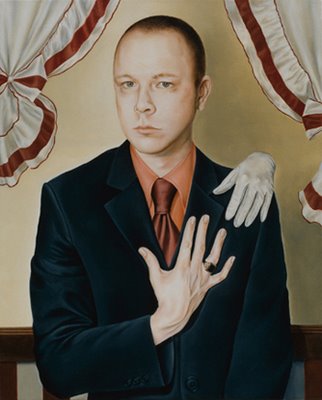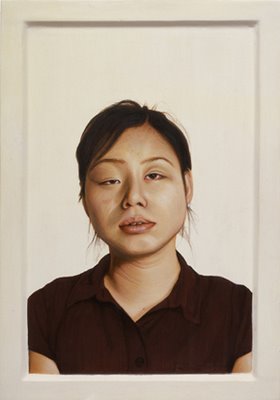Congratulations to all the contestants and especially to the Finalists in the 2006 Boochever Competition at the National Portrait Gallery.
Jenny Dubnau
http://www.portraitcompetition.si.edu/exhibition/PeoplesChoiceAward/EntryDetails.aspx?RID=13"

Artist Statement:
One of the most interesting aspects of portraiture, for me, is the way it can simply record a person. I like the idea that somewhere behind the fictionalized, painted version of the subject of a portrait lurks (or lurked) someone real. In my work, this idea of “realness” seems to crop up in the way the paint functions and in the use of photography, as well as in the imagery itself. I love using the paint to really describe the various textures of the human body: tongues, eyeballs, hair, teeth. A sense of verisimilitude, even if it disturbs, enhances the physical (mortal) presence of the subjects, and creates, for me, a tension between the psychological complexity of the sitter and her/his primal fleshiness. My paintings are made from photographs. Photographs are by their very nature “true,” in the sense that the camera lens is an ostensibly objective recorder of reality. This is of course both true and false: the photograph does offer a more literally real rendition of life than does painting, but at the same time contains mediations and oddities of its own: the exact moment the shutter is clicked, the blurring of the depth of field, and the strangely random cropping, to name a few. I like allowing photographic language to be engulfed, as I see it, by the language of painting, in which every formal move is intentional and is a potential site for metaphor. Using photographs as a source also provides linkage to the “realness” idea: we know that photos capture, in their near-cruel objectivity, what we “really look like,” meaning our flaws and particularities of physiognomy; expanding upon that idea in a painting context both intensifies and mediates that harsh objectivity.
Jared Joslin
http://www.portraitcompetition.si.edu/exhibition/PeoplesChoiceAward/EntryDetails.aspx?RID=17"

Artist Statement:
In art, as in life, directing one’s gaze towards the self is critical. When working in the realm of figurative painting, a self-portrait often serves as a checkpoint, a signpost to elucidate where life has taken you. Within this self-portrait are elements that function as signifiers. The gloved hand is my muse, that which brings dreams and encompasses the inexplicable. (It is also, on a literal level, my wife’s hand; She being the subject/muse of whom I most frequently paint portraits.) The environment within which I am situated, with peppermint-striped curtains and wainscoting, references the aesthetic of the early 20th century circus, a longtime influence and inspiration. The ring on my finger is a link to the past; it belonged to my late grandfather. As a young man during the Depression, he saved for many months to obtain it. It is symbolic of accomplishments gained through hard work and the reward that comes with that. Much in the same way, painting has given me great rewards through many years of devotion and discipline. I welcome you to explore more of my works online at: www.jaredjoslin.com.
Nathaniel Lang
http://www.portraitcompetition.si.edu/exhibition/PeoplesChoiceAward/EntryDetails.aspx?RID=23"

Artist Statement:
This portrait was begun when I learned that the subject would be leaving North Carolina, and was finished more than a month after she had gone. In my current work I paint my immediate circle of friends, isolating each person for closer inspection. Careful observation of individual faces creates a sense of physical familiarity. I want to suggest that we may intimately know someone’s face while never completely knowing his or her mind. I begin each portrait by taking a series of photographs, trying to capture a face in a light and a pose that seem both ordinary but visually interesting. I then translate these photos into egg tempera paintings. The brush strokes and the distortions that occur while painting become evidence of human labor and the effort required in striving to understand others.
Jenny Morgan
http://www.portraitcompetition.si.edu/exhibition/PeoplesChoiceAward/EntryDetails.aspx?RID=30"

Artist Statement:
Created during a time of intense personal transition, Falling Into is a self-portrait serving to question identity. Within the diptych format, the two images of self face each other, but are dramatically separated by the space between the two sister panels. The figures crouch down and both subjects, on opposing canvases, face inward. The cropping of the poses aids in conceptual meaning; the faces of both figures disappear within the vacant space and the viewer is left to mentally fill in the absence. Symbolically the red cloth is used to represent strong, deeply felt sentiment. As the two semi-mirrored bodies grasp the tense and stretched fabric at once they are connected emotionally, but still alienated from one another physically. The use of this fragmented image stands as a metaphor for looking inward and true personal investigation. "Falling Into" is the third painting in a three-piece series relating to this emotional transition. The other two works, The Fallout (a diptych) and Intermission (a panel) also pose these figures with a red cloth.
Sharon Sprung
http://www.portraitcompetition.si.edu/exhibition/PeoplesChoiceAward/EntryDetails.aspx?RID=42"

Artist Statement:
“A” was a waitress and bartender at a local bistro I frequent. I responded to her spontaneity and animation, always –moving—quick and unexpected. Proximity and repetition allowed me the opportunity to observe her before asking her to pose. She was a curious and willing model—uncharacteristically quiet when she viewed the results on my easel soon after the completion of the painting. We lost touch—she, off to something –else—an aggressive explorer who has lived all over the world. I thought the strongly colored, striped sweater reflected her enthusiastic, impatient and changeable character, infusing the painting with a contemporary image of a young, spirited female, ruled by will and the intent to experience life on her terms. The composition and surface combine my interest in a contemporary pictorialism with my respect for the skills of the past masters. I always attempt to meld this sensibility of the immediate present with the truth of nature, carefully and patiently observed. “A” and I continue to seek, she more restlessly than I.
Costa Vavagiakis
http://www.portraitcompetition.si.edu/exhibition/PeoplesChoiceAward/EntryDetails.aspx?RID=44"

Artist Statement:
My primary vehicle of expression is the human figure. Painting from direct observation, and with an emphasis on form, I aim to give expression to the sitter’s physiognomy. To accomplish this, I meticulously layer paint to develop the form. Working into the surface of the painting by repeatedly scraping and sanding, I make radical adjustments until both space and figure are fully articulated into a palpable image. Through creating the illusion that the image has been sculpted out of pigment, the figure can then be projected assertively into viewer’s space—heightening that can take several years to complete. This portrait is a painting of my dear friend Arthur Hammer, a fellow artist. We have drawn and painted each other for several years now. Like most of my portraits, they are not commissioned. They are personal statements, where light, form and space serve the sitter’s emotion.
Will Wilson
http://www.portraitcompetition.si.edu/exhibition/PeoplesChoiceAward/EntryDetails.aspx?RID=48"

Artist Statement:
My painting Convexed is a self-portrait in which I allude to aspects of my past, present, and future as an artist. The past is represented by the interior of the Schuler School of Fine Arts in Baltimore, Maryland, where I began my formal art training and taught for a number of years. I knew those sculptures well, as they were undying slaves used in my study of form and figure. The heroic plaster of Adam and Eve’s expulsion from the garden looms above my head. The pair is leaving Eden full of knowledge, but their journey promises to be a difficult one not unlike the transition from art student to professional artist. The present is shown by my “in the moment” act of painting, a process of creating which suggests our divine nature. The future is represented by the tip of the brush breaking what appears to be the hard and fast boundary of the frame’s gilded edge and moving into the mystery of the unknown. All at once the past and the future exist in the moment—the only place they can exist.
